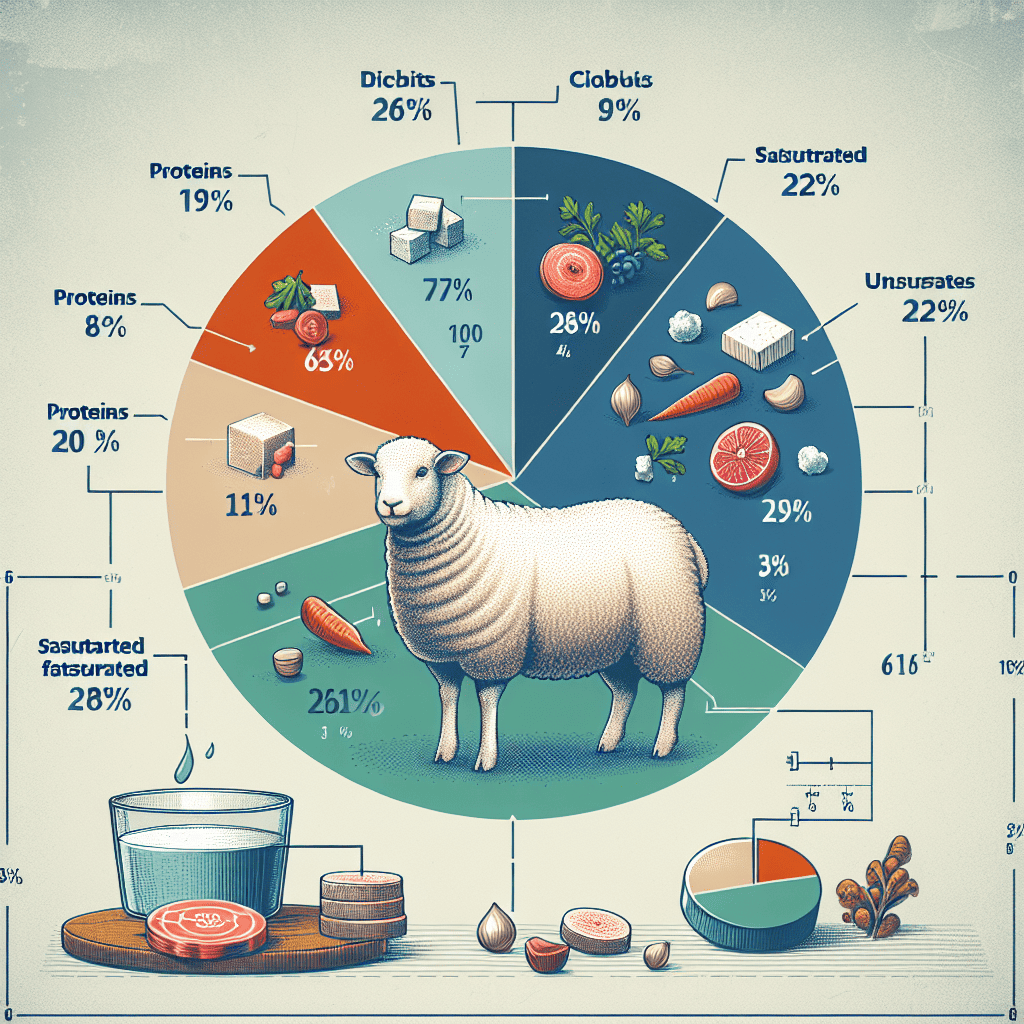Introduction: When it comes to lamb fat consumption, understanding its impact on health is crucial. This comprehensive guide delves into the nutritional composition of lamb fat, its potential health effects, and explores the various facets of incorporating lamb fat in your diet and lifestyle.
Table of Contents
Is Lamb Fat Good for Health?
Discover the nutritional value and potential health effects of lamb fat.
- Nutritional Composition of Lamb Fat:
Lamb fat is mainly composed of saturated fat and monounsaturated fat, with only small quantities of polyunsaturated fats. Saturated fat is known to increase LDL cholesterol levels which can contribute to heart disease and other health issues if consumed in excess. Monounsaturated fat, on the other hand, is considered a healthier fat that may help lower bad cholesterol levels and reduce the risk of heart disease. Although there are some potential health benefits associated with specific fats found in lamb fat such as conjugated linoleic acid (CLA), it is still crucial to moderate the intake of saturated fat for overall health.
To make healthier choices when consuming lamb fat, opting for lean cuts of lamb can reduce the saturated fat content. Removing visible fat before cooking and choosing cooking methods like grilling, roasting, or broiling instead of frying can also help lower the overall fat content of the dish. Incorporating a variety of foods rich in unsaturated fats like fatty fish, nuts, seeds, and olive oil into the diet can further balance out the fat intake and promote heart health. It is important to remember that the key to a healthy diet is moderation and balance.
In conclusion, while lamb fat contains a mix of different fats, including both beneficial and potentially harmful ones, the focus should be on managing the intake of saturated fat. By being mindful of the cuts of lamb chosen and the cooking methods utilized, it is possible to enjoy the flavors of lamb while reducing the associated health risks. Incorporating a diverse range of healthy fats from other sources in the diet can help create a well-rounded approach to fat consumption, supporting overall wellness and heart health in the long run.
- Considerations for Consumption:
Lamb meat is a rich source of essential nutrients like protein, vitamins, and minerals. Protein is crucial for building and repairing tissues in the body, while vitamins and minerals play various roles in maintaining overall health. For example, lamb meat is high in B vitamins such as B12, which is essential for nerve function and the production of DNA. It also contains important minerals like zinc, iron, and selenium, which play a role in immune function, energy production, and antioxidant defense.
However, lamb meat is also known for its relatively high fat content compared to other types of meat. This can be a concern for those trying to manage their fat intake or watch their weight. To address this issue, it is recommended to consume lamb meat in moderation and choose lean cuts whenever possible. Lean cuts have less fat and calories, making them a healthier option for those looking to enjoy lamb meat without compromising their health. Additionally, incorporating healthy cooking practices such as grilling, broiling, or roasting can help reduce excess fat content while still retaining the meat’s flavor and nutritional value.
Incorporating lamb meat into a balanced diet can provide a range of nutrients that are beneficial for overall health. By being mindful of portion sizes, choosing lean cuts, and practicing healthy cooking methods, individuals can enjoy the nutritional benefits of lamb meat without overloading on fat. It is essential to remember that variety is key in maintaining a healthy diet, so while lamb meat can be a valuable addition, it should be part of a diverse selection of protein sources to ensure a well-rounded nutrient intake.
The Nutritional Value of Lamb Fat
Explore the nutrient profile of lamb fat to understand its contribution to a healthy diet.
- Key Nutrients in Cooked Lamb:
Lamb is a great source of high-quality protein, which is essential for building and repairing tissues in the body. Proteins are made up of amino acids, some of which are classified as essential as the body cannot produce them on its own. Lamb provides all nine essential amino acids, making it a complete protein source for individuals looking to maintain or build muscle mass.
In addition to protein, lamb also contains various essential vitamins such as B12, niacin, and riboflavin. Vitamin B12 is crucial for the formation of red blood cells and proper nerve function, while niacin and riboflavin support energy production and metabolism. These vitamins play a vital role in maintaining overall health and well-being, making lamb a nutritious choice for meeting daily vitamin requirements.
Furthermore, lamb is a good source of minerals like iron and zinc, which are important for various bodily functions. Iron is necessary for transporting oxygen in the blood and preventing anemia, while zinc supports immune function, wound healing, and DNA synthesis. Including lamb in the diet can help individuals meet their daily iron and zinc needs, particularly for those who may have higher requirements such as pregnant women or athletes.
Types of Healthy and Unhealthy Fats
Distinguish between healthy fats that support well-being and harmful fats to avoid.
- Choosing Healthy Fats:
Incorporating monounsaturated and polyunsaturated fats into your diet can have a significant positive impact on heart health and overall well-being. Monounsaturated fats, found in foods like avocados, nuts, and olive oil, can help to reduce bad cholesterol levels in the blood, lowering the risk of heart disease. Polyunsaturated fats, such as those in fatty fish, flaxseeds, and walnuts, contain essential omega-3 and omega-6 fatty acids that play a crucial role in brain function and cell growth. By prioritizing these healthy fats, individuals can support their cardiovascular health and contribute to a more balanced and nutritious diet.
A diet rich in healthy fats also offers numerous other benefits beyond just heart health. Monounsaturated and polyunsaturated fats are more satiating than unhealthy saturated and trans fats, helping to keep you feeling full and satisfied for longer periods. Additionally, incorporating these fats into your meals can enhance the absorption of fat-soluble vitamins like A, D, E, and K, which are essential for various bodily functions. By making conscious choices to include sources of healthy fats in your diet, you can improve your overall nutrient intake and ensure that your body receives the necessary components to function optimally.
To prioritize healthy fats in your diet, focus on incorporating sources of monounsaturated and polyunsaturated fats into your meals while reducing the intake of saturated and trans fats. This can involve using olive oil for cooking, adding avocado slices to salads, snacking on nuts and seeds, and including fatty fish like salmon or trout in your weekly meal plan. Making gradual changes to your eating habits to include more healthy fats can lead to long-lasting health benefits, including better heart health, improved cognitive function, and overall well-being. By being mindful of your fat choices and making informed decisions about your diet, you can support your health goals and enjoy a more balanced and nutritious lifestyle.
- Avoiding Unhealthy Fats:
Trans fats are artificial fats created through a process called hydrogenation, which turns liquid oils into solid fats. These fats are commonly found in processed foods like baked goods, fried foods, and snack items. Consuming trans fats can raise bad cholesterol levels (LDL) and lower good cholesterol levels (HDL), leading to an increased risk of heart disease, stroke, and other serious health issues. In recent years, many countries have taken steps to ban or restrict the use of trans fats in food production to protect public health.
On the other hand, saturated fats are naturally occurring fats found in animal products like red meat, butter, and cheese, as well as some plant-based oils like coconut oil and palm oil. While small amounts of saturated fats are necessary for bodily functions, excessive consumption can also raise LDL cholesterol levels and contribute to cardiovascular problems. Therefore, it is essential to limit the intake of foods high in saturated fats and opt for healthier alternatives like lean meats, fish, and plant-based sources of fats like nuts, seeds, and avocados.
To maintain a healthy lifestyle and reduce the risks associated with trans fats and saturated fats, it is recommended to read food labels carefully and avoid products with trans fats listed in the ingredients. Instead, choose foods that are low in saturated fats and trans fats, and high in unsaturated fats like omega-3 and omega-6 fatty acids. Cooking with oils like olive oil or canola oil, incorporating more fruits and vegetables into your diet, and opting for lean protein sources can all contribute to a heart-healthy diet. By making informed choices and being mindful of your fat intake, you can help protect your heart and overall well-being.
Summary of the Article
Recap the key points regarding lamb fat’s impact on health and its versatile uses.
- Balancing Lamb Fat Consumption:
Lamb fat, like many animal fats, contains essential nutrients such as fat-soluble vitamins like A, D, E, and K, which are important for overall health. It also provides a good source of energy and helps in the absorption of fat-soluble vitamins. However, excessive consumption of lamb fat can lead to health risks such as high cholesterol levels, heart diseases, and weight gain. It is crucial to consume lamb fat in moderation to reap its nutritional benefits without compromising one’s health.
In order to strike a balance between the benefits and risks of consuming lamb fat, it is important to be mindful of portion sizes and frequency of consumption. Incorporating lean cuts of lamb and trimming visible fat can help reduce the overall fat content while still enjoying the flavor and nutrients that lamb offers. Additionally, pairing lamb dishes with plenty of vegetables, whole grains, and fruits can further enhance the nutritional value of the meal and mitigate the potential negative effects of consuming too much fat.
Being educated about the nutritional content of lamb fat and how it fits into a balanced diet is key to making informed dietary choices. Consulting with a healthcare provider or a nutritionist can also provide personalized guidance on incorporating lamb fat into a healthy eating plan. By understanding the benefits and risks associated with lamb fat consumption and practicing moderation in dietary habits, individuals can enjoy the nutritional advantages it offers while safeguarding their health in the long run.
- Unconventional Uses of Lamb Fat:
Lamb fat, known for its unique composition, is not only used in cuisine but also finds applications in cosmetics due to its various beneficial properties. In the realm of skincare, lamb fat is prized for its moisturizing and nourishing qualities. The fat is rich in essential fatty acids, antioxidants, and vitamins, which help in improving skin hydration, softening rough and dry skin, and combating signs of aging. These components make lamb fat an excellent emollient, promoting skin elasticity and offering protection against environmental stressors. In traditional medicine, lamb fat has also been used topically to soothe dry and irritated skin, making it a valuable ingredient in skincare products such as creams, lotions, and balms.
In addition to skincare, lamb fat is also utilized in hair care products for its conditioning and strengthening properties. The fatty acids present in lamb fat can help improve hair texture, prevent breakage, and enhance shine, making it a popular ingredient in hair masks, serums, and conditioners. Furthermore, the emollient nature of lamb fat can contribute to restoring the hair’s natural hydration levels and promoting overall scalp health. These benefits not only enhance the appearance of the hair but also support its overall health and vitality. As a natural alternative to synthetic chemicals, lamb fat offers a sustainable and eco-friendly option for those looking to incorporate natural ingredients into their hair care routine.
Moreover, lamb fat’s versatility extends to the production of soaps and other body care products. The fat’s creamy texture and moisturizing properties make it an ideal ingredient for creating luxurious and nourishing soaps. When used in soap-making, lamb fat can help produce a rich lather, cleanse the skin without stripping it of its natural oils, and leave the skin feeling soft and hydrated. This makes lamb fat a popular choice among artisan soap makers and natural skincare enthusiasts looking for high-quality and gentle cleansing products. With its diverse range of applications in cosmetics, lamb fat continues to demonstrate its versatility and potential beyond traditional culinary uses, showcasing the wide array of benefits it offers for skin, hair, and overall body care.




